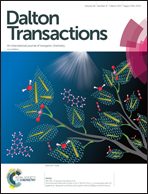A generic and facile strategy to fabricate metal–organic framework films on TiO2 substrates for photocatalysis†
Abstract
We present a facile and compelling method for the synthesis of metal–organic framework (MOF) thin films on TiO2-coated conductive glass substrates. This generic deposition approach is extended to five representative MOF films (e.g. UiO, MIL, IRMOF, and NU series) with high crystallinity and excellent surface coverage, achieving a MOF/TiO2 heterostructure interface. The tunable thickness and functionality of MOF films as well as the preferred orientation of MOF microcrystallites are described. After the incorporation of [Ru(bpy)3]2+ functionality via postsynthetic ligand exchange, the resultant MOF films serve as a robust and efficient catalyst for photo-oxidation of thioanisole. Importantly, our deposition technique avoids the direct contact between solid MOF catalysts and magnetic stirring, thus overcoming the problem that the vast majority of MOF powder catalysts are subject to defragmentation or decomposition under the physical treatment methods.



 Please wait while we load your content...
Please wait while we load your content...